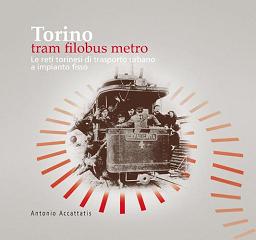Torino Tram Filobus Metro
Turin tramway, trolleybus and underground network

Edited by ETR - Salò
ISBN 978-88-85068-38-4
288 pages, glossy paper, 178 photos, 33 images - List price 35,00 €
The book can be ordered filling in the order form and sending it to Etr
In Turin the book can be bought at the stand of ATTS during the shows.
The book can be bought at main on-line bookshops, such as Webster and Libreria universitaria
It’s a detailed work based on a wide collection of documentation: municipality and local transport company publications, archive records, period newspapers and articles from specialized magazines. The work follows the pattern present in "Linee tranviarie a Torino": the first part of each chapter, focused on the evolution of the network, has been greatly enriched, as well as the history of each line has been rewritten with even greater detail. The first three chapters describe the development of the urban tramway network over three centuries and three concessionary companies. The following three chapters describe the wide interurban tramway network, the small but interesting trolleybus network and the development of underground line from the projects of the Sixties to recent realization.
A wide and extensive photographic documentation enriches the book: nearly 180 photos, in black and white and in color, half of them unpublished until now: line 3 at the triangle terminus in via Martorelli, line 6 at Piazza Carlo Felice terminus, line 8 in via Bergamo. And more, line 14 on Isabella bridge, line 17 at Piazza Modena terminus, special line 27 ; the tram to Orbassano the first voyage in 1934 on the Sassi-Superga the first trolleybus in 1902... and more than 30 pictures with routes and network plans.
In the appendix we can find the color tables (for a long time every route was identified with a color), the list of links and rings during the unification of networks, the night routes and the list of forced limitations on tram service due to bombing during World War II, and the funicular, the monorail, the ovovia.
Sbt-Stt tramway network. In 1872 the Société Belge-turinoise des Tramways (Sbt) and, after a few years, the Società Torinese di Tramways e ferrovie economiche (Stt) began to operate an urban transport service in concession; these two companies, at first in a competitive system and later in joint work, set up the first Turin tramway network. At first tram routes were operated with horse-drawn trams then, in the years around 1900, the entire network was electrified. In 1922 the Azienda Tranviaria Municipale (Atm) redeemed the concessions and unified the network.
Saeai-Atm tramway network. In 1897 another company began to operate in Turin in the field of urban transport, the Società Anonima Elettricità Alta Italia (Saeai), which obtained the concession of six new electric tram routes. In 1906 the Town Council of Turin enforced the redemption of this network and established Atm that expanded quickly until the outbreak of World War I. In the Twenties Atm redeemed the Sbt-Stt network, too, thus giving rise to a unified, widespread and functional network. After the Second World War, during the Fifties and the Sixties, the chaotic expansion of the town created difficulties for the tramway transport, which was heavily cut down and risked the suppression, in favor of new and more adaptable bus lines.
Atm-Gtt tramway network. In 1982 the network was completely redesigned according to the streams of traffic studies. Originally the project planned five new light rail routes and eight standard tram routes; actually only ten of them were put into operation. Between the twentieth and twenty-first century there was some bad and good news for Turin tram network: a couple of routes were suppressed, while the first underground line was started up and a modern tram route reached suburban districts as Falchera and Mirafiori Sud.
Suburban tramway network. Around 1880 some companies began to operate a suburban transport service: several steam tram routes linked Turin with surrounding villages as Moncalieri and Venaria, but also with more far away places as Pinerolo and Saluzzo. During the first decades of the twentieth century these routes were updated and electrified and some of them were taken over by the management of Satti public company. Due to hard coexistence with private traffic, none of these routes survived beyond the Fifties.
Trolleybus network. Although in Turin the trolleybus network was always secondary compared to tramway and bus network, an experimental trolleybus was put into service along a little urban route in 1902. So the capital of Piedmont was one of the first cities in the world to try these kind of vehicle. Turin trolleybus network reached its greatest extension in the mid-fifties with five urban routes and two interurban routes. From then on it began to decline, until 1980 when last trolleybus route was suppressed and replaced by a bus service.
The underground. History of Turin underground is a long sequence of projects, experiments, second thoughts and even urban tales. Only in 2006 it was, at last, inaugurated, during Turin winter Olympic Games. The first driverless underground line in Italy, opened along the route of old tramway route nr. 1, had immediately a huge success.